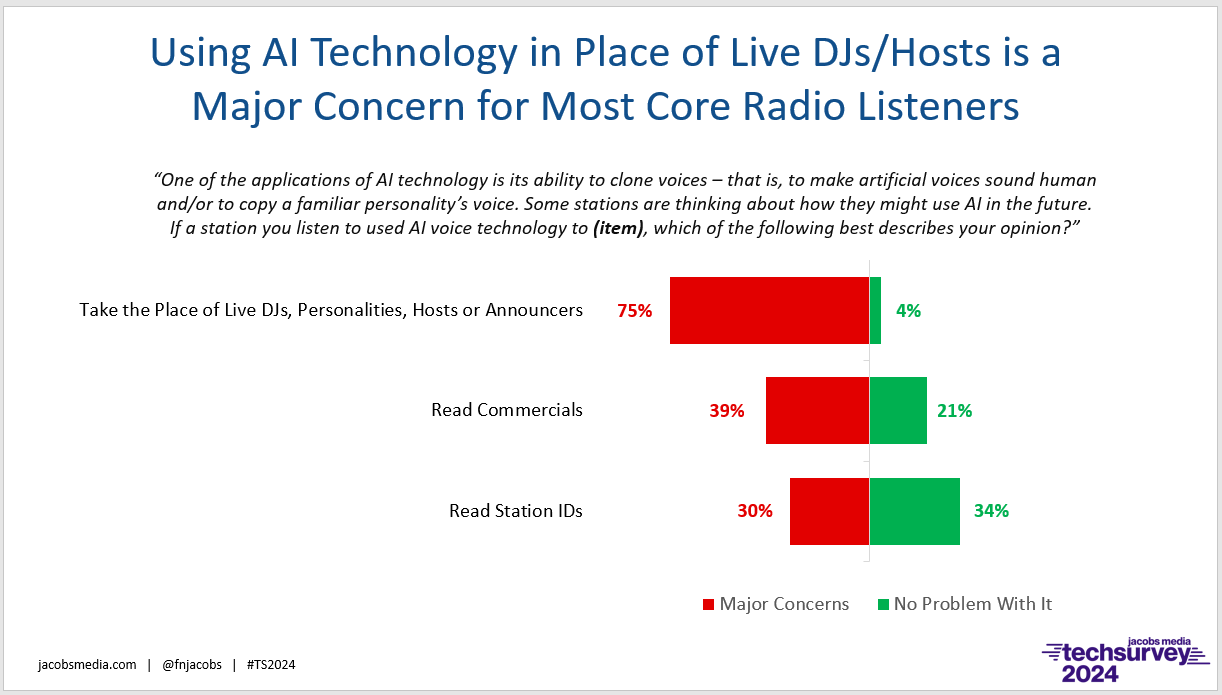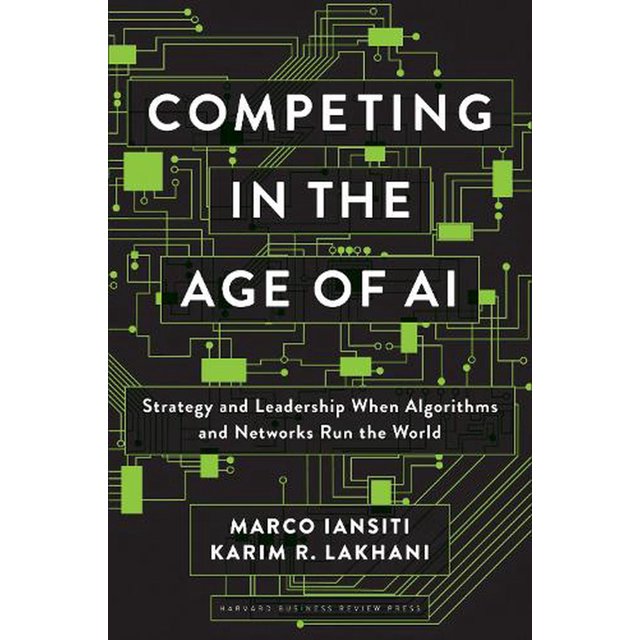Where do radio listeners draw the line with AI? [Fred Jabobs]
Radio suffers from an identity crisis amplified by increased competition on multiple fronts. AI could be a partial solution, but only if listeners are OK with it. Radio consultant extraordinaire Fred Jacobs explores…..
by Fred Jacobs of Jacobs Media
If CRS 2024 convened last week in Nashville proved to us about AI, it’s that we’ve come a long way in just 12 months. Rather than the finger-pointing and paranoia we heard in abundance at the 2023 show, attendees this year were mostly all-in. During our Town Hall session, it was a collaborative gathering where attendees shared their early use experiences with AI technology.
While there was virtually none of the paranoia and vitriol heard just 12 months ago, I suspect that for some radio people, it was bubbling under. And for good reason. While perhaps they were hesitant to express it, I still sense concern among programmers and talent about the prospect of companies misusing this technology.
But beyond the cynicism, is there reason for concern about how audiences perceive radio’s use of AI? At least for now, what will most listeners tolerate, and where will they draw the line? Those were the questions that drove our AI questions in the soon-to-be-released Techsurvey 2024. And more than 31,000 respondents representing key radio formats didn’t hold back.We approached AI content on three different levels:
- Commercial production – How do they feel about AI-generated voices on station ads?
- IDs and promotional production – Is it OK for stations to use AI to voice basic positioning and identification?
- Shows/airshifts – What about AI-voiced radio shows?
Admittedly, there are lots of variations of how stations produce the content very generally described above. The wording of these questions, and respondents’ own reference points for what we are asking about will vary. So, think of the results I’m going to show you in the generalist of terms.

They will give you an idea of audience sentiment, but they cannot provide a thumbs up or thumbs down acceptance or rejection of the content in question. After all, respondents are not actually hearing audio, but are asked to make a call based on a written description of how a station might use this technology.
Your willingness to research your own audience, coupled with how you produce and present the content will go a long way toward determining its passing muster or perhaps causing concern.
Think of these questions as a benchmark or starting point. As we have done with scores of other datapoints – smartphones, mobile apps, streaming, and other measures – a key to fully grasping the environment is to ask these questions over time, which we intend to do.

So, this year is the first inning, Square One – however you refer to it. It’s not the Holy Grail, but it’s a beginning. And it’s an opportunity to see the potential red flags with how radio broadcasters are going to use and position this technology.
We specifically worded the questions this way:
“One of the applications of AI technology is its ability to clone voices – that is to make artificial voices sound human and/or to copy a familiar personality’s voice. Some stations are thinking about how they might use AI in the future. If a station you listen to used AI technology to _________________, which of the following best describes your opinion?”
The blank above was “read commercials,” “read station IDs,” and “take the place of live DJs, personalities, hosts or announcers” on three successive questions randomized for respondents.
And they could use these responses:
- I would have major concerns with it
- I would have some issues with it
- I would have no problem with it
- Unsure/Doesn’t apply
Here’s how it looks:

Of the three, using AI in place of live talent is a deal-breaker for most respondents. An overwhelming three in four express major concerns about this “use case” for AI. Bear in mind, the question did not incorporate the idea of robots pushing humans out of their jobs, but it’s not a stretch to assume many likely read it this way. And perhaps that’s an accurate way of thinking about how AI might be used by at least some radio producers looking to not only streamline operations but do it for less money.
Using AI to “read” station identification fares the best of the three applications tested. But even there, nearly as many express major concerns as those who give it the green light. Again, this is why we intend to trend these responses over time. Just as CRS 2024 attendees softened their skepticism toward the technology over a year ago, it is likely that as consumers hear various AI applications in content, they may come to accept it more readily. Or not.
As we know, Spotify has created the artificially intelligent “DJ X,” while will.i.am recently introduced qd.pie, a cyber-sidekick on his SiriusXM show. Entertainment media are already walking down this techie path. Look for more “experiments” in this space, whether they are overt attempts like Spotify and SXM, or behind the scenes like how many others are privately dabbling in AI.

And that brings to mind the book Buzz Knight recommended to CRS attendees. Competing in the Age of AI by Marco Iansiti and Karim Lakhani is a book that looks at the ways industries and brands are using the technology, and in the process, redefining their competitive space.
The authors make the point that AI is helping companies in areas that include achieving scale, scope, and learning. We saw this in action at CES 2024 in January from mega-corporations like Walmart and Google, to startups at Eureka Park.
The book makes liberal use of case studies, not dissimilar to others in the tech category. Among the many companies they put through the AI lens is Netflix.
For the video streaming giant, there are some backend efficiencies from AI that subscribers don’t “see.” These include dynamic pricing and using A/B testing to select the most effective message to get their customers to respond to marketing messages.
Where the Netflix AI engine is more obvious to us is the ability to recommend content (movies, TV shows, docs, etc.) consumers might also enjoy based on their viewing patterns.
This is nothing new, of course. Netflix has employed algorithms for years, whether classified as AI or not. Obviously, the key is to perfect and hone their recommendation engine so the system operates like a trusted friend who knows our tastes and what we enjoy watching.
The results are still sketchy. Most of us can think of moments when something truly perfect was recommended to us by the Netflix bots. But it’s just as likely we can recall moments when a suggested show or film was strangely out of bounds or simply off-key.
The key, of course, is companies utilizing AI technology to create a better customer/subscriber (and in the case of radio, listener) experience. And it cuts both ways. When the AI is fine-tuned and operating well, we watch Netflix more, remain subscribers, and even put up with the steady stream of price hikes.

This last point is especially important because when a company “gets us” – whether it’s AI-driven or not – consumers often have a sense of appreciation, and might even be more likely to sustain a more expensive service.
When it comes to AI, radio broadcasters need to start with the same premise Netflix and other companies do. That is, how can we use this new technology to create a better experience for our customers.
Sadly, radio often asks how it can use an advance like AI to shave costs, create efficiencies, and accomplish more with fewer people. The listener is often the last consideration.
That’s why Techsurvey exists. We will continue to ask “What if?” questions, as well as explore how nascent technologies and their uses are accepted or rejected by listening audiences.
Stay tuned for the upcoming announcement of the Techsurvey 2024 industry webinar, in partnership with Inside Radio and sponsored by Quu. There are many new questions this year, besides this AI series, designed to glean a better understanding of how audiences perceive and embrace technology.
It’s a brave new AI world.

P.S. To help you stay ahead of AI developments, uses, and thinking about how it impacts radio, Jacobs Media’s Chris Brunt publishes a free newsletter, AI Edge. It’s a practical guide for radio broadcasters.
Click here to sign up for it and be sure you don’t miss a moment of how AI will impact radio broadcasting.